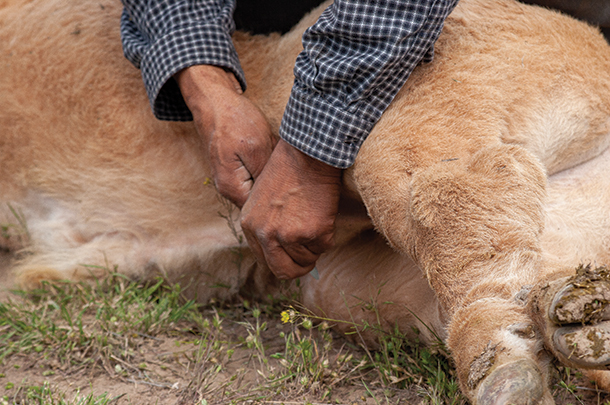Winter is here, but it will not be long before the snow and ice melt away and pastures start to green up and become lush. Springtime can bring a host of challenges for beef cattle.
Between warmer days and the potential of a spring blizzard, Mother Nature doesn’t make it easy. Throw in the endless mud, and the weather can throw off the health of any cow or calf. Uncontrollable weather causes stress and challenges immune systems, allowing pathogens to cause health issues such as bovine respiratory disease (BRD), foot rot and scours.
In addition to diseases and environmental challenges, feed prices remain high and there are growing requests from consumers to modify production practices. Maintaining a healthy herd with proven strategies helps producers meet all these demands while also maintaining profitability.
 Once calves are born, it’s important to tag calves and complete any newborn procedures such as castration, dehorning, dipping navels or determining if supplemental colostrum replacer is needed. Staff photo.
Once calves are born, it’s important to tag calves and complete any newborn procedures such as castration, dehorning, dipping navels or determining if supplemental colostrum replacer is needed. Staff photo.
5 tips to plan for spring herd health
There are a few things that should be done to help manage the cow-calf environment before spring begins. Here a few tips to direct the nutritional and health needs of cows and calves this spring.
1. Calculate body condition score
Cows need higher-quality feedstuffs during the final trimester and during early lactation to keep her and her calf healthy and performing to their full potential. Producers should pay attention to body condition scores (BCS) about 60 days prior to calving and throughout lactation. Producers should target a range between 5.5 and 6. Keeping cows above this level can run up feed costs and negatively impact performance and breedback later.
There is evidence that separating breeding females into two groups – one with a higher BCS and one with a lower BCS – can have positive impacts on a herd’s economics. It facilitates increased supplementation to lighter-weight cows to recover bodyweight and condition without overfeeding the heavier cows. This will improve reproductive performance and optimize feed costs for both groups.
2. Provide proper nutrition to the cow herd
Often, calving occurs well before grass greens up, sometimes several weeks before forage growth is sufficient for herd turnout. Yet, cows’ nutritional needs are at their peak 30 to 60 days postpartum.
Cows need adequate nutrition during lactation. Depending on bodyweight and milk production, a cow needs 14 to 20 pounds total digestible nutrients (TDN) per day. Energy needs increase even more during cold, wet conditions.
Not only does feeding performance trace minerals to lactating cows help improve wellness and performance of their offspring, but it also helps maintain proper BCS of the cow by improving forage digestion.
Complexed zinc, manganese and copper are well recognized for their roles in reproduction, immune function and calf growth. Often forgotten, however, is the impact of complexed cobalt on forage digestion, helping cows get more from every bite.
3. Support young calves with sound management practices
As calving approaches, ensure that a dry calving area is ready and it is cleaned in between calvings, if indoors.
Once calves are born, it’s important to tag calves and complete any newborn procedures such as castration, dehorning, dipping navels or determining if supplemental colostrum replacer is needed. Work with your veterinarian to review your pre-calving cow herd vaccination program.
Calf diseases can be minimized with good vaccination programs and nutritional management. When a calf is born to a cow that was supplemented with appropriate mineral nutrition during her pregnancy, it helps support a more competent immune system and leads to long-term health benefits, like a reduction in BRD.
4. Prepare for breeding season
Cow-calf producers can unlock improvements in reproductive performance and potential profits by implementing a quality mineral supplementation program in preparation of breeding season.
High-quality trace minerals should ideally be provided year-round and, at bare minimum, 90 days before breeding begins to ensure reproductive potential is fully realized. Research shows when producers are proactive in fulfilling their herd’s nutritional needs, they have more favorable reproductive responses.
Well-formulated mineral programs help cows generate quality oocytes and help improve sperm motility in bulls, resulting in higher conception rates, decreased calving intervals and fewer embryonic or pregnancy losses.
More than 70% of total pregnancy loss occurs in the first month-and-a-half after fertilization. That time is crucial in terms of overall reproductive success.
5. Manage spring grazing season
Producers should evaluate their current facilities by doing a perimeter check of fences and to determine how much green forage is growing among the dormant grasses.
It’s still important to consider proper mineral supplementation and added magnesium in the early spring due to the potential of grass tetany. Spring forages are often rich in potassium, and this can interfere with magnesium absorption. Despite the lush forage growth in the spring, forage mineral availability is variable, so it is important to work with your nutrition to ensure the cow herds’ mineral needs are met with proper supplementation.
Along with proper mineral supplementation, producers should also assess BCS of their cows again to determine proper stocking rates in their pastures.
Maintain profitability despite springtime hurdles
Despite the challenges spring can bring to producers, there are several practices that can be implemented to ensure sound health and optimum performance that ultimately translates to a lifetime of success for their herd.








